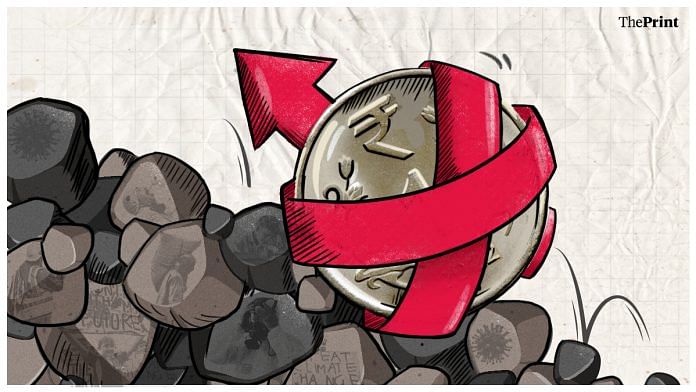The government’s macroeconomic strategy, as articulated through the Budget and the Economic Survey, can be stated simply: Growth will take care of all problems. That is what worked two decades ago, when the macroeconomic indicators were comparable to today’s fiscal deficits, heavy interest burden on public debt, and problem-ridden banks. Rapid growth in subsequent years, in a world economy that was on steroids, boosted tax revenues, which reduced the deficit and debt in relation to GDP, and helped digest the interest burden.
One advantage today, compared to the turn of the century, is that the banks have already been mostly fixed with regard to bad debt and capital adequacy. But back then, Yashwant Sinha’s bold slashing of rates had helped boost economic activity. Today, we have the opposite situation: Low interest rates that are climbing. Also, while the global economy was accelerating then, it is slowing now. So, if the government thinks growth is the solution, can it be delivered in a slowing world with rising rates — bearing in mind also the domestic context of slower growth even during the pre-pandemic phase?
The answer is that it well might, for the next two or three years. The high growth projections for the coming financial year must be seen as a continuation of the still partial recovery from the pandemic’s economic consequences. The April-June quarter will benefit from a low statistical base for the first quarter of 2021-22, which was hit by Covid’s second wave. And the economy is still grappling with production bottlenecks that should ease progressively. Growth forecasts of 7-8 per cent and even higher for 2022-23, on top of 9.2 per cent for this year, are therefore realistic.
Also read: When a write-off is a triumph: Why Air India sale has both Tata & govt in buoyant mood
Yet even a second year of rapid recovery would not entirely wipe out the after-effects of the Covid-driven recession of 2020-21, when GDP contracted by 6.6 per cent. Growth over the three years, 2020-23, would have averaged a decidedly modest 3.4 per cent. Arguably, there should still be an output gap that finds reflection in sub-normal capacity utilisation levels (because of constricted consumption) and, as a consequence, in sub-normal private sector investment and credit growth. If we assume a return to normalcy on those parameters in the course of 2023-24, plus some productivity benefit flowing from the infrastructure investment being undertaken, there could be another year or two of fairly rapid growth. Some early-bird results from the productivity-linked incentive schemes for manufacturing would act as an additional booster.
In such a scenario, the macroeconomic burdens of today (high levels of fiscal deficit and public debt, and interest on that debt) would have shrunk in relation to GDP, as they did in the century’s first decade. Barring shocks (including policy-induced ones), the economy should be humming along in the final upward phase of the business cycle before the tempo levels off.
This may sound optimistic but it is in fact not asking for too much. Growth over a seven-year span, 2018-25, would still average out at barely 5 per cent. That would be lower than the average that prevailed in the longer cycle of the previous one-third of a century. The difference would be explained substantially (but not wholly) by the pandemic, some of whose damage to output cannot unfortunately be recouped.
Leaving for the future the question of whether growth beyond 2025 can be maintained at a high pace, the question to ask today is whether such growth should be the sole measure of success. What about employment, poverty, the environment, education, and health — all of which have independent but also inter-linked salience, have suffered in the last couple of years, if not longer, and which the Budget seems to underplay? This is the K-factor debate, which the government assumes will disappear (or can be tackled) with sustained growth. Will it? On the medium-to-long term record, not automatically. Course correction in strategy is essential, if nothing else because sustainable growth depends on it. And more than that, for as Simon and Garfunkel sang half a century ago, “Asking only workman’s wages / I come looking for a job / But I get no offers… / Now the years are rolling by me…”.
By special arrangement with Business Standard
Also read: India must do homework before commercial contracts, no room for fuzziness in art of the deal



